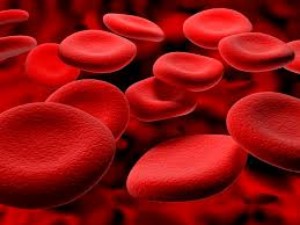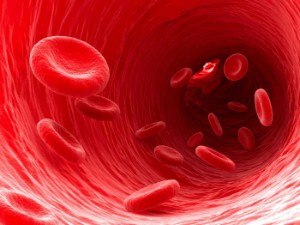Functions and structure of the red and yellow bone marrow in humans + 7 important vitamins for its work
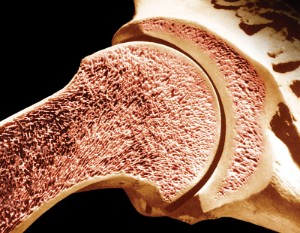 Ask any adult or child: what is the task of the human skeleton &8212; almost everyone will point to its musculoskeletal function. But bones have another equally important task – the production of blood cells.
Ask any adult or child: what is the task of the human skeleton &8212; almost everyone will point to its musculoskeletal function. But bones have another equally important task – the production of blood cells.
More precisely, the process of hematopoiesis does not occur in the bone tissues themselves, but in the bone marrow – a soft spongy substance that is found in humans inside hollow and some flat bones.
Blood is in constant chemical motion, like all tissues of the body, but it is it that is the most intensively renewing matter. This feature is explained not only by its "fluidity", but also because blood is the connecting link of absolutely all other organs.
In the human body, 5 billion leukocytes die and are born again every hour, 10 billion red blood cells and 20 billion platelets. The function of constantly maintaining the necessary blood composition lies on the bone marrow. It is also the central organ of the immune system.
Content
&171;Three Human Brains&187;
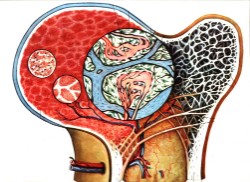 Each of us has three types of brain &8212; brain, spinal cord and bone. The first two fully correspond to the name familiar in the Russian sense, since they consist of neurons and are responsible for the work of the entire nervous system, including muscle contractions, motor skills, and reflexes, thinking
,
memory
and the ability to hear and speak.
Each of us has three types of brain &8212; brain, spinal cord and bone. The first two fully correspond to the name familiar in the Russian sense, since they consist of neurons and are responsible for the work of the entire nervous system, including muscle contractions, motor skills, and reflexes, thinking
,
memory
and the ability to hear and speak.
20 useful products for the brain, see here →
The bone marrow is not a brain in the literal sense of the word (in English it is called "marrow", unlike the brain "brain"), since there are absolutely no neurons in it, and it is no more connected with the work of the nervous system than with the work of all other organs &8212; indirectly through production blood cells.
The commonality of the name "brain" is explained by the similarity of the localization of all three organs – inside bones or vertebrae – so nature itself has placed these ultra-important "generators of life" under reliable protection.
The red bone marrow in Latin is medulla ossium rubra, and the yellow one is medulla ossium flava.
Structure and functions
In anatomy, histology and immunology, bone marrow is usually divided into:
- Red is active, directly producing stem cells – matrix prototypes of full–fledged blood cells. The main function of the red bone marrow is hematopoiesis, including the production of all cells of the immune system.
- Yellow is an accumulation of passive fat cells, however, which can be converted into stem cells if necessary.
Thus, the yellow brain plays the role of a guarantor or "reserve battalion" in the case of hematopoiesis: in case of a shortage of stem cells, due to various failures (diseases, operations, etc.), it "transfers to the red brain" the necessary amount of material to create them.
You can see its structure in the photo:

;
More details here:
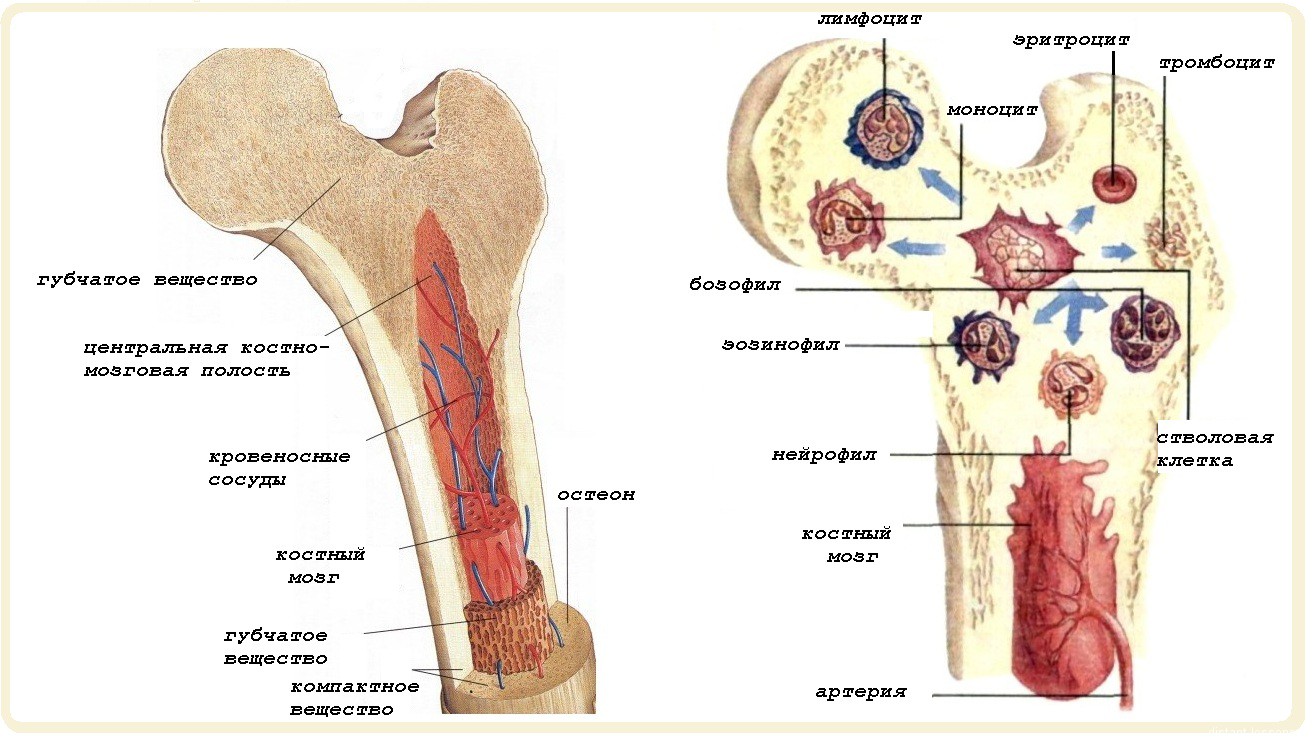
How much bone marrow do we have? We can talk about about 5% of the total body weight , and the red and yellow components account for half each.
It becomes clear that the vital importance of the bone marrow "hematopoiesis factory" is paramount, and any quantitative, qualitative and proportional disorders in cell production lead to serious diseases, of which anemia is the most common.
In a healthy person, the main blood depot is the red bone marrow, which is located in large numbers in the pelvic and tubular bones of the extremities. Other (spare) foci of hematopoiesis are the spleen and liver. It is significant that in the case of pathological disorders of normal hematopoiesis, these organs take on an increased burden for the production of blood elements necessary for the body.
Its development in the embryo
The biblical story of the creation of Eve from Adam's rib is not a literary allegory, and even more so not the inventions of the ancestors. It has been scientifically proven that the development of bone marrow in the collarbone begins in a human embryo at the age of 2 months.
During intrauterine human development, the potential of the hematopoietic organ accumulates:

- At the 2nd &8212; 4th months: red spongy material appears in the incipient flat bones (shoulder blades, occipital and pelvic bones, cranial, vertebrae and ribs);
- On the 5th month: the tubular bones of the extremities are filled with bone marrow;
- The first 10 weeks: the bone marrow performs an osteogenic (literally: "bone creation") function. In parallel, it accumulates stem cells – its main filler - to fulfill a lifelong hematopoiesis program;
- 12-14 weeks: differentiation of hematopoiesis (hematopoiesis): "a plan is being set" for classifying cells into erythrocytes, leukocytes and platelets;
- 20-28 weeks: Bone marrow canal formation;
- 36 weeks: fat cells of the bone marrow appear in the diaphysis of the tubular bones – a component of its yellow part.
7 types of foods that are good for bone marrow
Full healthy nutrition, rich proteins , with iron , zinc, cobalt are very important for maintaining the proper functioning of the bone marrow. The role of vitamins is also undeniable. First of all, we are talking about vitamins B, C, D, E and A.
1. Vitamin B12 .
 It is responsible for the maturation, formation and division of erythrocyte nuclei, as well as participates in the formation of other blood cells. Its importance for the body is proved at least by the fact that our own reserves of vitamin B12 can be sufficient for up to 5 years (the reserve is located in the liver).
It is responsible for the maturation, formation and division of erythrocyte nuclei, as well as participates in the formation of other blood cells. Its importance for the body is proved at least by the fact that our own reserves of vitamin B12 can be sufficient for up to 5 years (the reserve is located in the liver).
In addition, it is almost the only vitamin that does not break down under the influence of very high temperatures (heat treatment of products does not change the percentage of vitamin B12 in them). With a long–term deficiency of this vitamin, the so-called "megaloblasts" begin to be produced in the bone marrow - giant erythroid cells - the progenitors of giant erythrocytes.
The rate of their production is slowed down, and the life cycle is shortened – as a result, a lack of red blood cells is detected in the blood, and anemia is diagnosed. The natural source of vitamin B12 is products of animal origin only, namely:
- Liver (especially cod);
- Herring, fatty fish varieties, all seafood;
- Kidneys;
- Lean beef;
- Low-fat milk;
- Chicken eggs.
2. Vitamin B9 (folic acid). This vitamin provides DNA synthesis in the bone marrow. Its reserves in our body are much less than at 12, and therefore, after 1-6 months of its shortage, DNA synthesis and erythroid cell division are disrupted. As a result, the destruction is accelerated red blood cells , and anemia occurs. An adult needs 500-700 micrograms of folacin (folic acid) per day. Its sources are mainly vegetable and the greenest products. So, folic acid is rich in:

- Spinach;
- Nettle;
- Parsley, kindza, celery, lettuce;
- Legumes;
- Yeast;
- Grain bread;
However, there is enough folic acid in the liver, which is why this product is universal for bone marrow.
3. Vitamin B6 (pyridoxine). It is a kind of activator of the enzyme ALA synthetase, which produces heme in erythroid cells. Its low content also leads to anemia, due to impaired synthesis and Hemoglobin reduction . To replenish vitamin B6 reserves, consume:
- Cereals;
- All kinds of cabbage,
- Milk;
- Potatoes.
4. Vitamin D3. This element is involved in the differentiation of stem cells, namely in their full maturation to the forms of red blood cells,
white blood cells
or
platelets
. Its sources are:

- Cod and tuna liver;
- Fish oil;
- Herring;
- Cow's milk;
- Butter;
- Sour cream, cottage cheese, cheese;
- Egg yolk.
5. Vitamin A (retinolic acid). It has almost the same functions as vitamin D3 and is found in the same animal products. In addition, there is a lot of it in green and yellow vegetables and fruits:

- Carrots, pumpkin, sweet peppers, avocado;
- Spinach, broccoli, green onions, parsley, sorrel, parsley, nettle; mint;
- Legumes (soybeans, peas);
- Cherries, melons, watermelon, grapes, rosehip, apples, sea buckthorn, peaches, apricots;
- Medicinal herbs (borage leaves, burdock root, alfalfa, cayenne pepper, fennel, kelp, mullein, plantain, raspberry leaves, hops, horsetail clover, lemongrass, sage, bearberry, violet leaves).
6. Vitamin C. Thanks to it, the regularity of the stages of erythropoiesis is preserved, iron and folic acid are metabolized. To maintain the necessary vitamin C levels, consume:

- Citrus fruits every day;
- Green leafy vegetables;
- Melon;
- Different types of cabbage;
- Black and red currants;
- Sweet pepper;
- Baked potatoes in a uniform;
- Strawberries, apples, apricots, persimmons, rosehip, sea buckthorn, mountain ash,
- Tomatoes.
It is characteristic that of animal products, ascorbic acid is found only in the liver and kidneys of various animals.
7. Vitamin E (tocopherol) and vitamin PP (nicotinic acid). These are peculiar antioxidants. They prevent the membrane of red blood cells from peroxidation, which increases their hemolysis (destruction). There is a lot of vitamin E in:
- Vegetable oils;
- Cereals;
- Green beans;
- Peas;
- Bread;
- Nuts (especially walnuts).
To replenish vitamin PP, eat:
- White chicken meat;
- Kidneys and liver;
- Cheese;
- Eggs;
- Peanuts;
- Mushrooms;
- Green peas;
- Potatoes;
- Tomatoes;
- Legumes;
- Brewer's yeast.
Folk remedies
In pre-scientific medicine, when people had no idea about cells or blood cells, or that they originate in the bone marrow, there were many folk remedies for the treatment of anemia.
 Among the well-known to this day, the most accessible are:
Among the well-known to this day, the most accessible are:
- Decoctions of green leaves (spinach, nettle, raspberry). It is necessary to take a quarter cup 1-2 times a day.
- Elderberry syrup;
- Freshly squeezed pomegranate juice or two pomegranates per day;
- Juice of fresh red beetroot (beetroot is rubbed at night, granulated sugar is added to give juice, in the morning the raw material is squeezed out and taken half a glass 1-2 times a day).
Restoration of hematopoiesis after surgery
Even minor depression and dysfunction of the bone marrow is fraught with complications for the body. This is especially taken into account in clinics for the development of dietary tables, for example, for cancer patients after bone marrow transplantation.
Another case where enhanced nutrition is required for hematopoiesis to restore it is blood donation.
The main element of nutrition is fresh liver, especially beef and semi-raw. Its narrow strips are slightly fried in a hot frying pan right before serving, so that the color does not change inside. Every day you need to eat 100-200 g. For better absorption and taste, add fenugreek, saffron, turmeric.
Useful Video
We recommend watching this video:
Conclusion
The central role in the production of blood cells makes the bone marrow an organ of paramount importance. Maintaining all its functions normally means maintaining life in the body. It is not necessary to go into deep etymology to see the relationship of the words "blood" and "man" in ancient languages (in Latin: "hemo" &8212; blood, "homo" &8212; people).
The nature of blood is so complex that it requires the most saturated foods with acids, vitamins and fats to enrich it. A rich diet in general and a seasonal variety of dishes will help you maintain an excellent condition of the bone marrow – the life-giving forge of your body.

